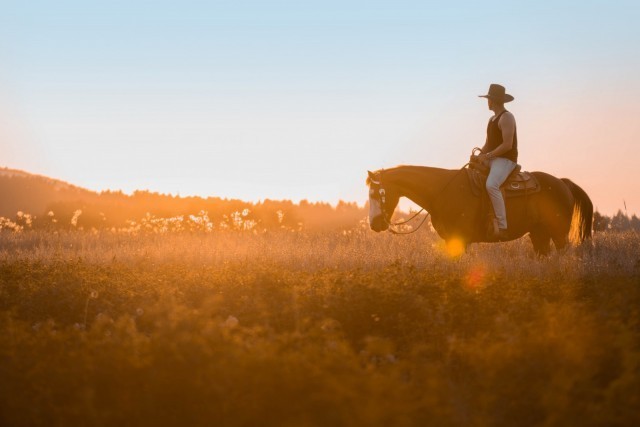LEISURE
Ing. Darina Havlíčková
Feed suitable for horses / part II. – LEISURE
Feeding leisure horses and their nutrition
The topic of feeding of leisure horses and their nutrition is as extensive as this group itself. This group includes horses ridden by pleasure riders and horses from horse riding ranches, riding clubs and riding schools. This group also includes sports horses with light and moderate activity, ridden by amateur riders in sports and hobby competitions. We can also include horses whose owners work them from the ground or horses working as therapy horses for hippotherapy and therapeutic organisations, in this group.
This definition shows that it is not easy to find one set of instructions for such a diverse group. But, in my opinion, it’s not about defining exact boundaries between the individual categories of leisure horse and creating complicated special feeds, but more about finding a common intersection point for all members of this category - leisure and less active sports horses. So we will chiefly be establishing the common needs of the leisure horse group and then we can separate the horses depending on how active they are.
The basic requirement of this group of horses is most definitely the aspect of health and base metabolism. Every horse, whether its activity is light, moderate, etc. needs basic nutrients, trace minerals and energy for its metabolism. Regardless of whether your horse is more or less active, its body needs nutrients and energy simply to survive and to maintain its basic functions (digestion, respiration, elimination), which assure its life. This means that a horse’s feed ration should always include minerals and vitamins (Energys® MINERAL, Energys® PONY). If the horse has any additional medical issues (breathing difficulties, tendency to suffer from colic, metabolic syndrome, orthopaedic diagnosis) it requires additional supporting supplements (Energys® MASH, Geloen HA, etc.)
The other important aspect in relation to leisure horses is their condition. The ideal tool for estimating whether my horse is too thin or too fat is the Body Condition Score (BCS) for horses. This is a system that began to be used in the USA in the nineteen eighties (the author is D. Hanneke). This is a system for assessing 9 categories of condition depending on the areas fat is most likely to be deposited. The ideal BCS value is 4 - 5. Of course, the condition of pastured horses is different and should be different in autumn and in winter, etc. An Akhal-Teke horse will not have the same condition as a Quarter horse or Haflinger. BCS is not “all-important”, but it is a good tool for owners or nutritional specialists. Some horse owners may mistakenly think that if the “horse is not doing anything” it does not have to be fed, which is confirmed by the sometimes catastrophic condition of very lightly used leisure horses. (BCS 1-3) The other extreme is the effort “to give your leisure horse a little extra”, which leads to metabolic disease in horses due to “excess”, such as insulin resistance (BCS 8 - 9). Very few people are capable of assessing their horse’s condition objectively. Don’t hesitate to contact us if you want your leisure horse’s condition to be assessed.
You can keep a lightly active,warm-blooded horse activity in good condition by selecting a suitable feed (e.g. Energys® RELAX), or a combination of feeds. In our experience, Energys® RELAX is sufficient for base metabolism and good condition in leisure horses, possibly combined with oats. This ration is suitable for and tested mainly on English thoroughbreds used for leisure riding. A combination of feeds (oats, barley, or a 1:1 mixture of barley/oats) with Energys® PONY feed, is also suitable. Riding school and commercial ranch owners, who use ponies and horses of rustic breeds for their clients (e.g. Huculs, Haflingers, Fjord horses and their crossbreeds) only need to feed them Energys® ONY at a ration of 0.2 - 0.75 kg (depending on the breed and live weight of the horse) twice a day.
And the third aspect we will discuss is performance and activity, which is the most variable and seasonal. Assessment of the horse’s natural temperament is very important in relation to this when selecting the correct feed for a moderately active sports horse. Energys® RELAX possibly with OMEGA is more suited for horses with hotter blood, who are more excitable. Energys® STANDARD is appropriate for horses who are less lively and rather placid. Both feeds should be given at a ration of 2 - 2.5kg/horse/day. In our experience, both these feeds can be combined with oats at a ration of 0.5 - 1.5 kg/horse/day. Energys® COLDMIX from the premium range of Energys products is most suitable for all sports horses who are moderately active. Energys® OMEGA is a very appropriate supplementary feed to give throughout the sports season, at a ration of 150 g/horse/day.
In all cases, horses should have ad libitum access to roughage, i.e. to hay (pasture), or haylage. Every horse also requires access to high-quality drinking water at all times.
Photo Eliška Váchalová
